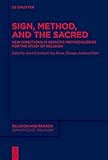Sign, Method and the Sacred : New Directions in Semiotic Methodologies for the Study of Religion / ed. by Jason Cronbach Van Boom, Thomas-Andreas Põder.
Material type: TextSeries: Religion and Reason : Theory in the Study of Religion ; 64Publisher: Berlin ; Boston : De Gruyter, [2021]Copyright date: ©2021Description: 1 online resource (XII, 320 p.)Content type:
TextSeries: Religion and Reason : Theory in the Study of Religion ; 64Publisher: Berlin ; Boston : De Gruyter, [2021]Copyright date: ©2021Description: 1 online resource (XII, 320 p.)Content type: - 9783110694727
- 9783110694949
- 9783110694925
- online - DeGruyter
- Issued also in print.
| Item type | Current library | Call number | URL | Status | Notes | Barcode | |
|---|---|---|---|---|---|---|---|
 eBook
eBook
|
Biblioteca "Angelicum" Pont. Univ. S.Tommaso d'Aquino Nuvola online | online - DeGruyter (Browse shelf(Opens below)) | Online access | Not for loan (Accesso limitato) | Accesso per gli utenti autorizzati / Access for authorized users | (dgr)9783110694925 |
Frontmatter -- Acknowledgements -- Preface -- Table of Contents -- Introducing new directions in semiotic methodologies for the study of religion -- PART I: Theoretical perspectives -- Religion in the semiosphere: Theosemiotics in dialogue with Juri Lotman -- Reveal and re-veil the sacred: Fetishism and fetishes in religious social discourse and practices -- Vain repetitions: The role of joint speech in enacting collective subjectivities -- Theology, metasemiosis and the ethics of attention -- PART II: Applications: Texts and case studies -- The semiotics of likeness: Identity, verisimilitude and falsity in Augustine -- An overlooked episode in the history of semiotics: The iconoclast controversy and its relevance for the iconic turn -- Semiotics against transubstantiation: Peirce’s reception of Berkeley -- A Peircean approach to late antique ascent texts -- On the Semiotics of Space in the Study of Religions: Theoretical Perspectives and Methodological Challenges -- Religion and the semiotization of space: The case of the Madonna del Rocciamelone -- Colors as a semiotic tool for Bible analysis -- Form and force of the sacred: A semiotic study of the temptations of Saint Anthony -- Authors and editors biographies -- Index
restricted access online access with authorization star
http://purl.org/coar/access_right/c_16ec
To what extent can semiotics illuminate key problems in religious studies, given the centrality of symbols, language, and other modes of signification in religion and theology? The volume explores semiotic methodologies for the study of religion, with an emphasis on their critical and creative reconfigurations. The contributors come from different specialties, such as cognitive science, ethnography, linguistics, communication studies, art studies, religious studies, philosophy of religion, and theology. Part One consists of chapters focusing on theoretical perspectives. Part two focuses on applications in texts and case studies while still considering methodological issues. Many specific traditions and perspectives are taken up, such as C. S. Peirce, A. J. Greimas and the Paris School, Juri Lotman’s semiotics of culture, Bruno Latour and material semiotics, linguistic anthropology, social semiotics, cognitive semiotics, embodied and enactive perspectives on language and mind, semiotics of the image and iconicity, multimodality, intertextuality, and semiotics of colors. The book provides readers with a succinct overview of how contemporary semiotics can be useful in understanding a broad array of topics in the study of religion.
Issued also in print.
Mode of access: Internet via World Wide Web.
In English.
Description based on online resource; title from PDF title page (publisher's Web site, viewed 28. Feb 2023)


